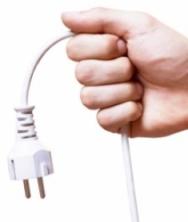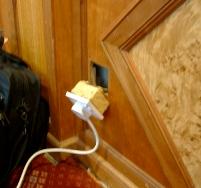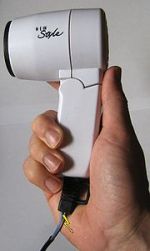Categories: Novice electricians, Electrician at home, Safety precautions
Number of views: 25913
Comments on the article: 1
About electric injuries and how to deal with it
 The development of human thought has led to the emergence of various devices designed to simplify our lives. However, this to some extent pushed humanity closer to that dangerous line beyond which the harm caused by the device will exceed its benefit.
The development of human thought has led to the emergence of various devices designed to simplify our lives. However, this to some extent pushed humanity closer to that dangerous line beyond which the harm caused by the device will exceed its benefit.
Electricity is the driving force of the entire modern process of life; many vital systems cannot do without it. Nevertheless, many people die or receive damage from electricity. Therefore, we can conclude that a characteristic feature of the development of electricity supply and power consumption is electric injury.
Injury has become a social phenomenon and is the subject of study not only of medicine alone. The problems of preventing and eliminating injuries should be addressed mainly by organizational and technical measures. These include the reliability and durability of equipment, the proper organization of its operation, training in safe methods of handling mechanisms, components, etc.
The one-sided understanding of the basics of injuries ("Do not do this, otherwise it will be bad!" Or "Do not get in, KILL !!!"), a vague knowledge of the causes that cause it leads to the fact that many injuries are not fully disclosed. Consequently, large sums of money are spent on protective measures that are not substantiated by true need and are not confirmed by statistical data.
In order to prevent this from happening, it is necessary at least to make sure that the concept of electrical injury is clear to everyone and everyone.
What is injuries?
In medicine, trauma is understood as the result of an action, not the action itself. Trauma is formulated as “a violation of the anatomical relationships and functions of a tissue or organ with a local or general reaction of the body caused by the excessive action of environmental factors on a person. This definition does not give clarity in the division of injuries into industrial and domestic, which leads to difficulties in the investigation of injuries, and especially electrical injuries.
To date, there is the following division of work-related injuries: mechanical, burns (thermal, chemical, electrical), frostbite, heat stroke, and other work-related injuries.
It should be noted, however, that this classification has its drawbacks. In it, for example, radiation burns are not provided, electrical injuries are assigned to the group of burns (while most of them caused by electric current are not accompanied by burns). No separate acoustic and optical injuries. To exclude them, specific protective measures are required.
 In the Great Soviet Encyclopedia, the term "Injuries" defined as follows: “Injury - a set of injuries in certain groups of the population over a certain period of time, an important indicator of the impact of social living conditions on the health status of the population ... There are industrial injuries (industry and agriculture) and non-injuries (household, transport, sports, .. .).
In the Great Soviet Encyclopedia, the term "Injuries" defined as follows: “Injury - a set of injuries in certain groups of the population over a certain period of time, an important indicator of the impact of social living conditions on the health status of the population ... There are industrial injuries (industry and agriculture) and non-injuries (household, transport, sports, .. .).
The growth of occupational injuries is directly related to the development of industry. The growth of domestic injuries is associated with urbanization, the massive introduction of mechanical and electrical devices into everyday life. ”
It can be argued that injuries - set of injuries recurring in a similar labor, transport, domestic or other setting. It is expressed by the number of events that occurred over a certain time (for example, during a year) per the accepted number (even 100,000) of the inhabitants or per 1,000 employees of a given specialty or industry.
Under electrical injury should be understood as "injury caused by exposure to electric current or electric arc", and by electric injury — "A phenomenon characterized by a combination of electrical injuries".
The following electrical injuries should be distinguished:
-
associated with violations of the normal operation of electrical equipment, in which an electric circuit is formed through the human body or as a result of which a person finds himself in an electromagnetic field of high tension,
-
associated with violations of the normal operation of electrical equipment, in which there is no electric circuit through the human body, and a person is injured due to burns, mechanical injuries, blinding by an arc, etc.,
-
mixed, in which the victim is jointly affected by the factors specified in both previous paragraphs,
-
Mixed trauma is trauma, when at the moment of formation of an electric circuit through the human body, electric current, temperature and penetrating radiation act simultaneously
Household electric injury
 Each of us is closer not to what is happening somewhere out there, but to what directly concerns us. Therefore, first of all, we will consider the problems of household electrical injuries.
Each of us is closer not to what is happening somewhere out there, but to what directly concerns us. Therefore, first of all, we will consider the problems of household electrical injuries.
Household electrical injuries include all injuries associated with current that occur in everyday life, that is, in house, apartment and communal networks.
Household electric injury is a sore spot in modern civilization. None of the countries, even developed ones, where the level of technical culture and education of the population is high, has managed to achieve the safe use of electricity in everyday life.
Finding an explanation for this is very simple: everyone knows that the insulation of household appliances is less reliable than that of industrial electrical equipment. The gap between the number of industrial and domestic electrical injuries is palpable and is increasing more and more.
The number of household electrical equipment in operation is constantly growing. If you count all the televisions, refrigerators, electric shavers, electric gas lighters, electric fireplaces, electrified toys and other electrical appliances available in the apartments of a modern apartment building, you can see that in terms of number and total installed capacity they exceed the electrical equipment of a factory or a medium-sized factory.
But if any enterprise is subject to requirements for specialized supervision of the implementation of labor protection and electrical safety rules, and this supervision is carried out by energy inspectors, technical inspectors of trade unions and other specialists, then the operation of household electrical equipment is the responsibility of the tenants themselves and the hostel’s commandants, i.e. persons without a special classification group for electrical safety.
The condition of the electric networks of the living quarters is checked only upon their delivery by the builders after construction or major repairs. Repair, as a rule, is carried out at best only after the equipment comes into emergency condition. In addition, almost no one bears responsibility for poor-quality repairs, as a result of which electrical shock can occur.
In recent years, workers in communal electricity networks have done significant work to improve the reliability of domestic electricity networks. The insulation quality of household appliances has improved.
Along with this, there are dozens of types of electrical equipment, the operation of which was accompanied by electrical injuries, sometimes with severe outcomes. In general, household electrical injuries increased and, most alarmingly, the number of electrical injuries caused by children, even very small ones, increased significantly.
The reasons for this lie in the significant shortcomings in the insulation of portable electrical equipment wires, in the operation of outdated plug sockets and plugs in construction, in the sale of electrical equipment to the population that is unsuccessful in design and lacks sufficient electrical insulation, and, finally, in the repair of even complex electrical equipment by non-electrical professionals. The latter primarily relates to the artisanal repair of televisions, radios, washing machines powered by 220 V.
There have been many cases of gross violation of the rules of the device of electrical equipment during its temporary connection, especially the electric lighting of Christmas trees, portable lamps.
It should be said separately a few words about Christmas garlands with their sparkling lights that children like so much. You should always remember the consequences of using "self-made" handicraft garlands made by persons of non-electrical professions.
Severe outcomes have been reported in students living in dormitories. The information of the population about the need for qualified maintenance of household electrical appliances is completely insufficient.
It should be noted that the operation of vehicles that are in personal use by the population is carried out by strict and systematic supervision by traffic police. Why is the operation of potentially dangerous household electrical equipment not under the supervision of state and public organizations? You can’t put up with such carelessness!
 Of course, it is not easy to carry out reliable apartment-by-apartment electronic supervision. And the difficulties are not only organizational. One of the difficulties is the lack of a unified idea of the mechanism of electric shock and the hazardous parameters of the latter and the strict and sufficiently substantiated standards for the quality of household electrical equipment.
Of course, it is not easy to carry out reliable apartment-by-apartment electronic supervision. And the difficulties are not only organizational. One of the difficulties is the lack of a unified idea of the mechanism of electric shock and the hazardous parameters of the latter and the strict and sufficiently substantiated standards for the quality of household electrical equipment.
An analysis of household electrical injuries shows that it is removable. Proof of this is the lack of a direct link between a significant increase in household appliances and the number of electrical injuries.
The reduction, and in some cases the complete elimination of electrical injuries in lighting networks, indicates that even simple measures such as the introduction of the electrical safety system "plug-socket", increased requirements for electrical insulation of household appliances and household wires bring success.
Replacing the outer metal frames of the lighting cartridges with plastic has virtually eliminated the electrical injuries associated with electric shock when trying to replace a failed lamp. Only in rare cases do they occur now when the lamp is screwed into the holder with wet hands. Quite frequent before electrical injuries when using switches with metal casings disappeared. Now only plastic covers are in use.
The source of electrical injuries is still the plug of the plug socket of portable household appliances.
The number of electrical injuries during the artisanal repair of a household body, radio, and also video equipment and other household electrical equipment has significantly increased by people who do not know the basic principles of electrical safety and perform this repair in unsuitable conditions.
It is necessary to indicate that there are a number of simple measures that allow, if you cannot exclude the possibility of household injuries, then at least reduce its likelihood: when you wash the refrigerator, other household electrical appliances, change the light bulb or fuse, turn off the general power switch in the apartment, do not keep household appliances turned on in the bathroom, as conductive water vapor forms there.
A radio speaker or a light bulb connected to the network and falling into the bathtub while swimming causes serious consequences.
 Sockets should not be too close to the bathtub or sink, never use a hair dryer or electric shaver if it is wet or has bare conductive ends or parts, and do not remove the plug from the socket by pulling on the cord (it may break off, exposing live conductors ), do not repair the plugs of electrical appliances with electrical tape, change them immediately if they break.
Sockets should not be too close to the bathtub or sink, never use a hair dryer or electric shaver if it is wet or has bare conductive ends or parts, and do not remove the plug from the socket by pulling on the cord (it may break off, exposing live conductors ), do not repair the plugs of electrical appliances with electrical tape, change them immediately if they break.
Do not hold the iron with wet hands and do not iron while standing on the floor barefoot, as in the event of an electric shock, this will facilitate the passage of current through the body into the ground, remember that the iron cord attracts children, and keep the iron out of the reach of them, never leave the included electric iron unattended, do not wind the cord around a hot iron, this may damage the insulation of the wire, before pouring water into the container of the iron steamer, pull the plug out of the socket.
Do not plug more than one plug into the outlet, several plugs can cause a short circuit and fire, when you have finished using the extension cord, first unplug the plug from the outlet, and then turn it off, exposed bare spots and wire breaks should be repaired immediately, do not make temporary wire connections , Allow all qualified personnel to complete all work.
Do not forget the most elementary safety standards when installing Christmas tree electric garlands, when repairing live appliances on your own, remember the golden rule for the fitter: keep one hand behind your back (since in this case the risk of injury with a fatal outcome is much less).
Back to the heating batteries. Essentially, touching batteries, water pipes, and taps can be considered as touching one of the electrodes through which an electrical circuit can occur. This consideration greatly expands the understanding of the occurrence of an electrical circuit through a well-grounded, natural ground electrode, such as a battery.
Once again, we note the need for two main measures: increasing the electrical strength of all elements of electrical equipment in everyday life and the presence of a specific service that provides at least selective control of the insulation reliability.
Currently, the energy supervisory authorities have a department of industrial enterprises. This includes construction organizations, trade enterprises, institutions, etc. Departments dealing with apartment networks should be created. One of the main tasks is to explain to the population the dangers of electric current.
The fact that this is possible is evidenced by the experience of Japan. There are years in this country in which no electrical injuries have occurred and there are no electrical injuries in persons of electrical professions.
So, we examined the basics of domestic, "home" electrical injuries. It becomes clear that in the presence of some preventive measures, household injuries can and should be eliminated.
I.D. Kovalenko, T. B. Mirtalibov
P.S. For what you need to know and do when you independently operate electrical equipment and wiring in a country house, see here.
See also at bgv.electricianexp.com
:
